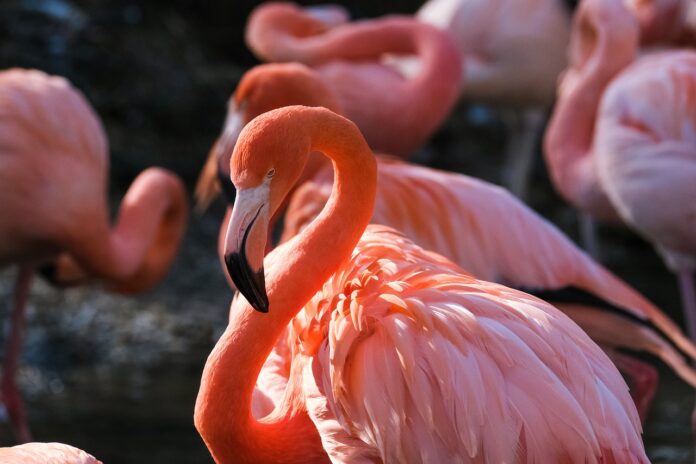Flamingos are not only pink, although this species is famous worldwide for its vibrant plumage. They lead a lifestyle closely connected to water, much like herons and some storks. Unfortunately, in today’s world, some species of flamingos are on the brink of extinction as the ever-expanding human civilization pushes them out of their natural habitats.
Facts About Flamingos:
- One-Legged Standing: Standing on one leg requires no effort from them at all. By tucking the other leg against their body, these birds reduce heat loss from the wind, which significantly cools their featherless limbs.
- Massive Flocks: In East Africa, flamingos group into enormous flocks that can number over a million individuals. These are the largest bird flocks on the planet.
- Survival in Harsh Conditions: Flamingos can thrive in extreme environments where few other species can survive. They are often found in highly saline or alkaline lakes, which have large populations of brine shrimp, a major food source for them. Flamingos can also be found in high-altitude lakes and can withstand significant temperature fluctuations.
- Feeding Habits: When feeding, flamingos lower their heads into the water, sucking in water through their beaks and filtering out edible particles, which they consume while the water is expelled. Tiny hair-like filters help them sift through food and release the water.
- Ancient Origins: The ancestors of modern flamingos lived on Earth around 30 million years ago.
- Size and Weight: The smallest flamingos grow to about 70-80 cm (27-31 inches) and weigh 2-2.5 kg (4.4-5.5 lbs). The largest can reach up to 1.5 meters (4.9 feet) in height and weigh 3.5-4 kg (7.7-8.8 lbs).
- Pink Plumage: In reality, pink flamingos have rather pale plumage. Their Caribbean counterparts, however, appear much brighter, with almost red feathers.
- Feeding Adaptation: Flamingos have a special buoyant organ that helps them feed by allowing them to keep their heads upside down while maintaining them on the water’s surface.
- Social Birds: Flamingos are social birds that live in groups of varying sizes. They gather in flocks when migrating and prefer to stay in groups when on land.
- Egg Consumption: The eggs of some flamingo species are consumed as food by various cultures.
- Flight: Flamingos can fly, but they need a short running start to take off. During flight, they extend their long necks and legs in a straight line.
- Diet-Dependent Color: The distinctive pink color of flamingos depends on their diet. They feed on algae and shrimp, which contain carotenoid pigments that turn into red pigments during digestion.
- Zoo Diet: Flamingos in European zoos are fed large amounts of carrots to prevent their feathers from fading.
- Non-Monogamous: These birds are not monogamous. They form pairs during the breeding season, but in the next season, they find new partners.
- Single Egg: Each female flamingo lays only one egg, which is carefully guarded and incubated.
- Lifespan: The average lifespan of a flamingo is around 30 years. In the wild, they live slightly shorter lives, but not by much, as they have few natural predators.
- Nest Construction: Flamingos build their nests on the ground, similar to herons. They usually surround them with 25-30 cm (9.8-11.8 inches) high walls to protect against rising water levels caused by heavy rains. The nests are made from mud.
- Gray Chicks: Flamingo chicks hatch with gray feathers. They develop their pink hue later, over the first two years of life.
- Extinction in Australia: Flamingos used to inhabit Australia, but they have long since gone extinct there. They are also not found in Antarctica.
- Caucasus Populations: Flamingos can be found in the Caucasus region, with small populations present in Azerbaijan.
- Sleeping on Trees: Flamingos prefer to sleep in trees, and they cannot fall from them while sleeping. When they doze off, their toes reflexively grip the branch tightly, so they can rest without worry.
- Sole Species in the Former USSR: Pink flamingos are the only species of their kind that inhabit the former Soviet Union.
- Longevity: Flamingos can be true long-livers. The officially recorded longevity record for a flamingo is 84 years!
- National Symbol: Flamingos appear on the flag of the Caribbean nation, the Bahamas.
- Gender Similarity: Male and female flamingos look identical, making it difficult even for experienced ornithologists to distinguish between them by appearance alone. Only their behavior indicates their gender.
